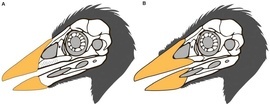Keratinous beaks in Confuciusornithiform Birds.
[sciencythoughts.blogspot.com]
The beaked rostrum is one of the most distinctive features of Birds, present in all living species and exhibiting an enormous diversity of form and size relative to the body. Although this morphological diversity is commonly associated with various feeding strategies, the actual relationship between shape and function is far more complex. In some extant Birds the rhamphotheca, the keratinous sheath that covers the edentulous bony rostrum and together form the beak, forms specialised structures such as filters (e.g. Flamingos) and 'teeth' (e.g. Mergansers) that facilitate certain feeding behaviors. In addition to its primary role in feeding, the beak has evolved a myriad of other functions including sound production (e.g. billclattering/culmen knocking in Storks), warfare (e.g., Toucans, Long-billed Hermit Hummingbirds), thermoregulation (e.g. Toucans), and inter and intraspecific signaling (e.g. Toucans, American Goldfinches, King Penguins). The keratinous beak is a dynamic feature, it grows continuously as it is also constantly worn away through use and can change in size, shape, and colour in response to seasonal differences in functional requirements.


Enjoy being online again!
Welcome to the community of good people who base their values on evidence and appreciate civil discourse - the social network you will enjoy.Create your free account
2 comments
Feel free to reply to any comment by clicking the "Reply" button.Didn't knew they continued to grow .
The same material as hair and fingernails.
Recent Visitors 18
JoeB
UK
AnneWimsey
Groton,
BitFlipper
Rochester,
seattlepanda
WA, USA
EyesThatSmile
Gulf Coast Of Texas,
Photos 292 More
Posted by JoeBKite-like structures in the western Sahara Desert.
Posted by TriphidAn Aussie Indigenous Message Stick.
Posted by TriphidIndigenous Australian Aboriginal Rock art dated somewhere between 20 and 30 thousand years old.
Posted by TriphidIndigenous Australian Aboriginal Rock art dated somewhere between 20 and 30 thousand years old.
Posted by TriphidIndigenous Australian Aboriginal Rock art dated somewhere between 20 and 30 thousand years old.
Posted by TriphidIndigenous Australian Aboriginal Rock art dated somewhere between 20 and 30 thousand years old.
Posted by JoeBDortoka vremiri: A new species of Dortokid Turtle from the Late Cretaceous of the Hațeg Basin, Romania.
Posted by JoeBThe Cabeço da Amoreira burial: An Early Modern Era West African buried in a Mesolithic shell midden in Portugal.
Posted by JoeBMusivavis amabilis: A new species of Enantiornithine Bird from the Early Cretaceous Jehol Biota of northeastern China.
Posted by JoeBTorosaurus in Canada.
Posted by JoeBStone tools from the Borselan Rock Shelter, in the Binalud Mountains of northeastern Iran.
Posted by JoeBDating the Lantian Biota.
Posted by JoeBBashanosaurus primitivus: A new species of Stegosaur from the Middle Jurassic of Chongqing Municipality, China.
Posted by JoeBDetermining the time of year when the Chicxulub Impactor fell.
Posted by JoeBSão Tomé and Príncipe: Possibly the last country on Earth never to have been visited by a working archaeologist.
Posted by JoeBMambawakale ruhuhu: A new species of Pseudosuchian Archosaur from the Middle Triassic Manda Beds of Tanzania.






